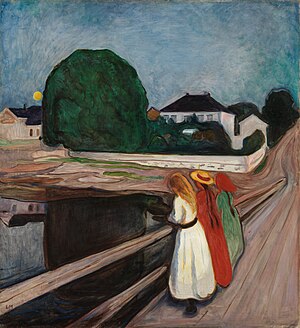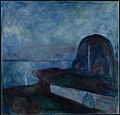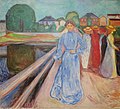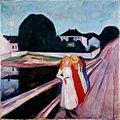Girl on the bridge

|
| Girl on the bridge |
|---|
| Edvard Munch , ca.1901 |
| Oil on canvas |
| 136 × 125 cm |
| Norwegian National Gallery , Oslo |
Girls on the Bridge ( Norwegian Pikene på broen , also The Girls on the Bridge , in other versions Women on the Bridge or The Women on the Bridge ) is a motif by the Norwegian painter Edvard Munch , which he painted for the first time in 1901. It shows a group of girls or women who have gathered at Åsgårdstrand's jetty . Munch processed the motif with different figure constellations between 1901 and 1940 in a total of twelve oil paintings and five graphics .
Image description
The foreground is divided diagonally by a footbridge that is strongly tending towards a perspective vanishing point and, with the road that follows, exerts a real “deep suction” on the viewer. Three young women are leaning against the railing. The first in the front is wearing a white dress with a black belt and has long, blonde hair. Your neighbor has a red dress and a yellow sun hat with two long, brown braids falling from below. The third one also has a braid. She wears a green dress and a red headscarf. While the two girls in the back gaze into the distance, the blonde has lowered her gaze and looks into the dark water. A mighty treetop is reflected there, which fills almost the entire left half of the picture and, in terms of composition, forms a contrast to the footbridge with the three women. The tree is in an enclosed property with white walls. There is a yellow moon far from the tree.
interpretation
According to Ulrich Bischoff, the motif goes back to an everyday situation in Åsgårdstrand that Munch experienced many times: girls await their admirers at Åsgårdstrand pier, with whom they want to go out, or women await their husbands returning home. The risen moon in the nevertheless bright night belongs to a Nordic summer night . However, it is the deviations from the realistic model that define the picture for Bischoff. The bright clothes of the girls create a cheerful mood, which is at the same time contrasted by the gloomy, threatening shadow in the water. He seems to be particularly attracted to young women, as is Munch's characteristic “pillar of the moon” in other pictures (e.g. The Voice ). In Girls on the Bridge there is no reflection of the moon in the water, only the dark tree is mirrored and thus takes the place of the "moon column".
The Voice (1893), oil on canvas, 88 × 108 cm, Museum of Fine Arts, Boston
Starry Night (1894–95), oil on canvas, 135.6 × 140 cm, The J. Paul Getty Museum , Los Angeles
The Scream (1893), 91 × 73.5 cm, Norwegian National Gallery, Oslo
The Dance of Life (1899–1900), oil on canvas, 129 × 191 cm, Norwegian National Gallery, Oslo
Hans Dieter Huber sees girls on the bridge as a “modular” combination of many well-known motifs from Munch's work. The Kjøsterudgården estate in the background, with its tall linden trees that merge into a single silhouette, can already be found in the starry night . The steep diagonal of the footbridge is reminiscent of The Scream . There, however, according to Bischoff, there is a dynamic in the depths, while the footbridge in Girls on the Bridge now leads upwards, as if it were an answer to the earlier picture. Huber assigns the girl in front with a white dress and blond hair to a type that can be found in many of Munch's pictures, that of the innocent woman as in The Dance of Life or The Woman in Three Stages . Analogous to the last picture, Munch conveyed his ideas of the life cycle in the form of three girls to sexual maturity: after the white of innocence, the red of the second symbolizes the awakening eroticism, the green of the third symbolizes first jealousy.
Other versions (selection)
Girls on the Bridge (1901), oil on canvas, 84 × 129.5 cm, Hamburger Kunsthalle
Women on the Bridge (1903), oil on canvas, 203 × 230 cm, Thielska galleriet , Stockholm
Four Girls on the Bridge (1905), oil on canvas, 126 × 126 cm, Wallraf-Richartz-Museum , Cologne
Girls on the Bridge (1933–35), oil on canvas, 80.5 × 69.3 cm, Kimbell Art Museum , Fort Worth, Texas
Between the years 1901 and 1940 Munch created a total of twelve oil paintings of this motif, see also the list of paintings by Edvard Munch . In five versions, the groups of people are clearly assigned to adult women because of their appearance and clothing, the others show adolescent girls. In the later compositions with three or four girls, the first girl faces the viewer. In the version of the Wallraf-Richartz-Museum (created in 1905), however, only a colored surface can be seen instead of the face. Therefore Jürgen Schultze sees in this version "an almost Fauvist independent color". Thanks to the bright colors, the picture exudes optimism and sensual liveliness. The museum itself describes the picture quite differently as “abysmal”, “nightmarish” and terrifying. In a privately owned version from 1902, the girls are grouped in a circle. Compared to the first version, this version is characterized by increased sharpness and greater contrast .
The colors of Women on the Bridge from 1902 have also lightened, the scene seems to have moved from night into day, and there is no threat of any kind. The composition, in which one woman stepped out of the group of the others, is reminiscent of Munch's painting The Storm from 1893. In the woman in the foreground he probably portrayed his childhood friend Aase, wife of the lawyer Harald Nørregaard . In the version of Thielska galleriet in Stockholm from 1903, Munch retains the group of women built like a pyramid, but contrasts them with three men in dark clothes who are leaning on the railing. Despite the generally lighter color and cheerful note of the pictures, according to Ulrich Bischoff, the themes from the life frieze (age, man-woman relationship) remain decisive for Munch. In the later works, however, Munch increasingly elaborates the gaps in the motif, which can also be interpreted as a symbol of loneliness, and thus includes his own lifetime in the work, according to Dieter Buchhart .
Munch produced a total of five graphic versions of the motif. An etching in a copper plate from 1903 (in Gerd Woll's catalog raisonné , no. 232) is a mirrored version of the painting from the Hamburger Kunsthalle . A woodcut from 1905 (Woll, no. 271) is a mirrored version of the painting from the Norwegian National Gallery or the Pushkin Museum . A lithograph from the years 1912/13 (Woll, no. 416) takes up the motif of the group of girls gathered in a circle in the privately owned painting from 1902. A woodcut from 1918 (Woll, no. 628) and a lithograph from 1918–20 (Woll, no. 629) again reproduce the motif from the Norwegian National Gallery.
Pictorial history
The first version of Girls on the Bridge , then called Summer Night , was made in the summer of 1901 in Åsgårdstrand , a place where Munch had long spent the summer months and where many of his well-known pictures were taken. At its first exhibition the following year at the Berlin Secession , it was enthusiastically received by contemporary critics. For Max Liebermann it was Munch's best painting and Walter Leistikow wanted to buy it, but Munch had already promised the Norwegian art collector Olaf Schou it as a replacement for the painting Zwei Menschen (The Lonely) , which had recently been destroyed during a ship transport . Schou donated the painting to the Norwegian National Gallery in 1909.
Ten of the twelve paintings made by Munch are in public collections; two more privately owned. A version from 1902, the provenance of which has been traced back to various private collections since 1915, was auctioned off at Sotheby’s to an unknown buyer in November 2016 for almost $ 54.5 million . At this point, of the works of Munch - after a version of The Scream - it was the one for which the second highest price had been paid.
literature
- Ulrich Bischoff : Edvard Munch . Taschen, Cologne 1988, ISBN 3-8228-0240-9 , pp. 68-72.
- Hans Dieter Huber : Edvard Munch. Dance of life . Reclam, Stuttgart 2013, ISBN 978-3-15-010937-3 , pp. 105-106.
- Jürgen Schultze: Girls on the Bridge, 1905 . In: Edvard Munch . Museum Folkwang, Essen 1988, without ISBN, cat. 67.
- Gerd Woll: Edvard Munch - complete paintings: catalog raisonné . 4 volumes. Translation from Norwegian. Thames & Hudson, London 2009
- therein the numbers: 483; 484; 539; 540; 541; 566; 567; 604; 639; 1632; 1715; 1721
- Farther; 542: single portrait from 541; 624: Kjøsterudgården in Åsgårdstrand ; 1713: the pier with boats with the same scenery
- Gerd Woll: Edvard Munch. Catalog raisonné of the graphic . Translation from English by Matthias Wolf. Munich: Beck, 2001 ISBN 3-406-47971-5
- therein the numbers: 232; 271; 416; 628; 629
Web links
- The Girls on the Pier, around 1901 in the National Museum Oslo .
- Edvard Munch: Pikene på broen (Girls on the Bridge) - Version that wasauctionedat Sotheby’s in November 2016.
- Four girls on the bridge in the Wallraf-Richartz Museum .
Individual evidence
- ↑ a b c d Hans Dieter Huber: Edvard Munch. Dance of life . Reclam, Stuttgart 2013, ISBN 978-3-15-010937-3 , p. 105.
- ^ Ulrich Bischoff: Edvard Munch . Taschen, Cologne 1988, ISBN 3-8228-0240-9 , p. 68.
- ^ Ulrich Bischoff: Edvard Munch . Taschen, Cologne 1988, ISBN 3-8228-0240-9 , pp. 68-69.
- ^ Ulrich Bischoff: Edvard Munch . Taschen, Cologne 1988, ISBN 3-8228-0240-9 , p. 70.
- ^ Ulrich Bischoff: Edvard Munch . Taschen, Cologne 1988, ISBN 3-8228-0240-9 , pp. 69-70.
- ^ Ulrich Bischoff: Edvard Munch . Taschen, Cologne 1988, ISBN 3-8228-0240-9 , p. 69.
- ^ A b Hans Dieter Huber: Edvard Munch. Dance of life . Reclam, Stuttgart 2013, ISBN 978-3-15-010937-3 , pp. 105-106.
- ↑ a b c d Edvard Munch: Pikene på broen (Girls on the Bridge) - Version that was auctioned at Sotheby’s in November 2016 .
- ↑ Jürgen Schultze: Girls on the Bridge, 1905 . In: Edvard Munch . Museum Folkwang, Essen 1988, without ISBN, cat. 67.
- ↑ Four girls on the bridge in the Wallraf-Richartz-Museum .
- ^ Ulrich Bischoff: Edvard Munch . Taschen, Cologne 1988, ISBN 3-8228-0240-9 , pp. 71-72.
- ↑ Dieter Buchhart : Edvard Munch - Signs of Modernity. The duality of a material-based modernity . In: Dieter Buchhart (ed.): Edvard Munch. Signs of Modernism , Hatje Cantz, Ostfildern 2007, ISBN 978-3-7757-1912-4 , p. 17.
- ^ Gerd Woll: The Complete Graphic Works . Orfeus, Oslo 2012, ISBN 978-82-93140-12-2 , pp. 232, 269, 416, 627-630.
- ↑ The Girls on the Pier, approx. 1901 in the National Museum Oslo .
- ↑ Munch painting auctioned for $ 54.5 million . On: Spiegel Online from November 15, 2016.













